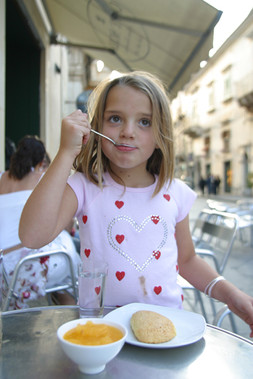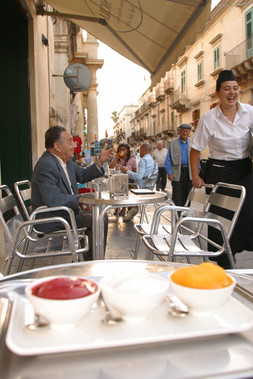Getting in their licks - A Sicilian gelato tour
May 27, 2007 - The Boston Globe

PALERMO, Italy—Sicilians are known for taking art forms like Baroque architecture and elevating them to their highest or wildest levels. On a hot summer’s day in Sicily, however, art is served in a cup, cone, or brioche.
Here, gelato (Italian for frozen) is the all-encompassing term that covers ice cream, sorbet, and granita , and their best creations can transport you directly to a pistachio grove at the base of Mount Etna or place a perfect strawberry on the tip of your tongue.
It may boil Neapolitan blood to think it, but on a hunt for the best gelato in the world, all roads might lead to Sicily.
A Sicilian “giro del gelato,” or gelato tour, is not only a beautiful excuse to visit the island , but also a way to understand why the frozen confection is more than a summertime treat, why it is a rite that links its inhabitants with their land, their fellow Sicilians, and the past.
They are demanding customers. A gelateria that is not up to snuff will be empty while a neighboring stand will have a crowd spilling out the door. Asked if he has any competition in the town of Cinisi , master pastry chef, chocolatier, and ice cream fanatic Santi Palazzolo flashes a modest grin.
“I did.”
“We eat a lot of gelato,” he says. “People eat it every day from the morning into the night.”
Palazzolo is not exaggerating. A typical Sicilian breakfast consists of a brioche filled with granita (think: Slushee from heaven), washed down with a tiny shot of nuclear-grade coffee. Later in the day, people may finish their lunch with a cone, enjoy it as an afternoon snack, make it part of their evening walk, or have it as a midnight treat.
“It’s 40 percent of our summertime income,” Palazzolo says, and considering that his pastry shop is one of Italy’s best, that is no mean feat. In summer, his gelato is such a popular late-night treat that he keeps the shop open until 2 a.m.
Ask where this ingrained, round-the-clock habit comes from and Palazzolo will look puzzled.
“We had snow on Mount Etna and beneath it grew fruit like lemon and oranges,” he says, “Arabs in Catania used it to create sorbet.”
This is Palazzolo’s polite way of explaining that it’s not a habit, it’s a way of life.
On the opposite end of the island in the beautiful Baroque town of Noto is Corrado Assenza , part pastry chef and gelato master, part philosopher. At Caffè Sicilia , gelato is one of the tools he uses to connect Sicilians to the ground beneath their feet.
 A customer jokes with a waitress at Caffe Sicilia in Noto.(Photo by Joe Ray/for The Boston Globe)
A customer jokes with a waitress at Caffe Sicilia in Noto.(Photo by Joe Ray/for The Boston Globe)The lessons of the gelato maker go far beyond getting something cool and tasty into his customers’ mouths. There’s a pared-down perfection to Assenza’s creations that is a quirky contrast with his town’s elaborate architecture.
“We have a strange way to understand history,” he says, placing a small white bowl of strawberry granita on the table below my nose, “but this is the way to understand.”
Pressed for specifics on how he makes this connection, he responds with a rhetorical question, “What kind of strawberry do you use?”
“You need to understand the difference between this variety and all of the other ones,” he explains. “Then you bring everything you can to the strawberry. You need to upgrade the flavor.”
He sounds like his friend Ferran Adrià , the Spanish star chef of El Bulli restaurant , who says he likes to make dishes that taste more like the product they are made from than the product itself.
Assenza actually blushes at the comparison and smiles until he notices that I haven’t touched my granita. He then makes a face that says nothing more will come from him until I taste it. I obey, and closing my eyes, the connection is made: I am in the middle of a strawberry patch.
“I choose my ingredients to find my footpath to your taste,” he says.
Later, digging into a chocolate gelato at Caffè Sicilia, Californian Evan Fuller, 6, sounds like she’s been taking classes from Assenza.
“It’s very, very good,” she says between bites. “It actually tastes like chocolate. It has more of the flavor of what it’s really supposed to be. At home, it doesn’t really have the flavor.”
So this is better?
“Yeah,” she says without hesitation.
In a nondescript ice cream shop in the north central town of Cerda, people gather around the entrance of the Gelateria Cappadonia where Antonio Cappadonia tackles the unromantic task of describing gelato making.
“These are my machines: uno, due, tre,” he says, pointing out his Pastoplus 30 pasteurizer , another mixer with submarine periscope-style handles and a cooling machine that resembles an industrial Maytag. “Made in Germany—60,000 euros [$81,000],” he says proudly.
Wearing his Accademia della Gelateria Italiana chef’s whites, he pours the base—a mixture of milk, cream, sugar, and a powdered emulsifier—from the pasteurizer, adds some pistachio paste from the Sicilian town of Bronte , and blends it in the mixer before pouring it into the cooler.
He lets me do the honors of pressing the button that sets the machine whirring.
Cappadonia does a nice job of explaining the process, but between the stainless steel machines that hide the action and the white tiles, fluorescent lights, and bags of emulsifier in his lab, it’s not exactly the sexiest creation process in all gastronomy.
In desperation, I plunge my head into the industrial-sized can of pistachio paste and breathe in deeply. Woozy with the aroma, I lose track of time.
Cappadonia taps me on the shoulder. He offers me a bite of the world’s freshest ice cream and with a mouthful of cool, toasted pistachios, I’m back on Assenza’s footpath, this time on a Bronte pistachio farm in the shadow of Mount Etna.
Downstairs in his shop, Cappadonia waves at his father at the cash register and his brother Giuseppe , who helps make gelato when he’s not working at a local bank. I ask Cappadonia why he has isolated himself in a town that would be left out of the guidebooks if it wasn’t for the annual artichoke festival, and he laughs.
“My father invited me to do this with him 20 years ago,” he says. “Gelato is part of our ‘bagagliaio culturale.’ Dad saw this as a way to connect with people and do business.
“I don’t care where I do it, I just want to do it well,” he adds, “and this is family.”
Back in Palermo, family, friends, and all walks of life are linked by gelato. Two gelaterias—Da Carlo and Da Ciccio—located across the street from one another on the Corso dei Mille , duke it out for their clients’ affections. Da Carlo, a relative newcomer to the scene, woos Palermitans with a sign announcing “Brioche Calde con Gelato,” where calde, or hot, is underlined three times. At Da Ciccio, a golden vat of Nutella topping floats over the ice cream in the cooler, and they also offer home delivery on a Vespa .
On a Sunday afternoon, both places overflow with people of all ages, all with their favorite form of gelato in hand. Two-year-old s with chocolate-covered faces mill around with goofy grins and preteen girls in fake Dolce & Gabbana clothes move in tight packs. There are middle-aged couples, grandparents, and teens on scooters.
It’s horns, Vespas, sunglasses even though the sun’s not out, cigarettes, litter, family, and lots of strutting. It’s a little kid wearing two shades of orange clothes and his dad with the same two shades on his cone. It’s a guy who rides by with a cardboard license plate taped to his scooter and a micro fender-bender in the street and the Italian-style arm flapping that goes with it.
It’s a big scoop of Sicily.
Joe Ray, a food and travel writer, can be reached at www.joe-ray.com.
If you go…
Where to get gelato
Palazzolo
Via Nazionale, 123 Cinisi
011-39-091-866-5265
pasticceriapalazzolo.com
Caffè Sicilia
Corso Vittorio Emanuele, 125 Noto
011-39-093-183-5013
Gelateria Cappadonia
Via Roma, 153 Cerda
011-39-091-899-1681
Gelateria Da Ciccio
Corso dei Mille, 73 Palermo
011-39-091-616-1537
Gelateria Da Carlo
Corso dei Mille, 72 Palermo
Where to stay
Nacalino Agritourismo
Corso da Nacalino Modica
011-39-0932-77-90-22
nacalinoagriturismo.it
At this beautiful bed-and-breakfast in rural southern Sicily, the adjoining farm supplies the morning’s milk and an occasional mouthwatering ricotta cheese; $47-$58 per person. Dinner and wine $27.
Palazzo Speciale
Via Giuseppe Mario Puglia, 2 Palermo
011-39-091-33-21-73
palazzospecialepalermo.it
.(JavaScript must be enabled to view this email address)
Located above a spectacular courtyard, including a room with a private rooftop terrace (make sure to ask for it), this B&B is in a quiet spot in the center of the city ; $162 for a room for two. For more than one night, rates go down.
Where to eat
Nangalarruni
Via delle Confraternite, 7 Cefalu
011-39-092-167-1428
Far into the hills above this seaside town, Giuseppe Carollo is one of the most respected chefs in Italy. Carollo is a mushroom specialist with a light hand that leaves you feeling more like you’ve just finished a healthy sushi dinner, not a heavy Sicilian one. A several-course menu is a bargain $40. Bonus: He stocks gelato from the nearby Gelateria Cappadonia.
Il Duomo
Via Capitano Bocchieri, 31 Ragusa Ibla
011-39-0932-651265
ristoranteduomo.it
Chef Ciccio Sultano’s product-based approach that makes wise nods to the past has earned him a solid reputation. Dinner about $139.